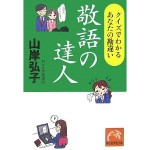Good books are all over the place and I want to share them with you! I figure if you’re still reading this, you care, so…I mean…it beats shaking down random people in the street and trying to recommend books to them. Star Trek fans know what I’m talking about: you want the rest of your family and friends to love it, but they don’t, so you find your ST buddies…sort of like a cult.
Cult? AJATT. AJATT? Books. Books? Today’s book: a handsome little tome on keigo and how to use it.
| Title/Author/Info | Pros | Cons | Comments |

Keigo Grand Master: Quiz Your Way to Keigo Greatness Language: Japanese Furigana: No |
|
|
Good book. Not really for going through in one sitting. This is a “keeper”, one you’re going to want to come back to from time to time and add to your SRS piecemeal.
(Maybe you can make yourself a separate keigo deck if your SRS allows easy deck management like, ahem, Surusu 😛 ) Another word of advice…a lot of people used to tell me this and I thought it was the cheesiest double McCheese thing ever, but now I think they were right: keigo is valuable and important, but basic kindness and a smile are even more important; it is possible to deliver cold-hearted keigo, but…what a waste. 😉 Having said that, gaijin are rarely short on personality but do sometimes (frequently?) come up a teeny bit lacking in refinement and etiquette — I’m one to talk! — so…getting yourself some solid keigo would be a worthwhile exercise. Speaking of color…gol darn, man…This is a beef I have with manga as well…I am more than willing to pay someone to get some color up in here! Like I said, the highlighting puts English-language books to shame. A lot of English-language business book authors seem to have these weird pretensions to novel-writing. They seem to want to tell you a story. As a reader, let me tell it straight up: I don’t need your story! Story-telling may have worked for The Richest Man in Babylon, but that was a one-book stand! We just kind of let it slide because George Clason was so smooth about the whole thing. We were young; we were inebriated; he was charming… Business writers, businesspeople, heed my call: I know that neither academics nor artists respect you; I know you want to be considered “real” writers of artistic and intellectual value; I know that being thought of as nothing but rich philistines grates on your self-esteem, but just get over it and give me some bold type and bullet points, big fella! Tom Peters knows what I’m talking about. |

>Cult? AJATT. AJATT? Books. Books? Today’s book.
どこから突っ込めばいいんだ…
Me likes the table format for book recommendations.
Does it come with an audio CD or anything to hear the examples? Or, should we take it to RhinoSpike?
You know, I’m pretty sure some religions actually pay people to shake random people down on the street and recommend very specific books to them. I sense a profitable career opportunity for you in the near future…
Seconding yuzuruさん’s sentiment about the table format. I’m diggin’ it.
Another book to add to my list of books to buy… It sounds really nice.
>”but just get over it and give me some bold type and bullet points, big fella!”
Simplify, basic-iffah, concise-iffah! Gib me dem bullet points!
I wonder if you’ve checked out “REWORK” by 37 Signals.
37 Signals, Tom Peters, Seth Godin… God I love their conciseness.
I like when you post references to materials in Japanese. Actually, some of the japanese wikipedia links gave me a quick little reading exercise.
I’m curious, do you know of any japanese language blogs that are entertaining?
Thanks for this post, I’ll definitely be needing this soon 🙂
Wonderful post. I also found a website with interesting material for learning keigo (for business):
koakishiki.com/index.html
Enjoy!
While looking for this book I found a similar one called 敬語入門 (Keigo 101) that has some similar features. It is aimed at college graduates who are becoming new 社会人 and as such gives some good practical advice about the right attitude to have in various business situations, as well as example usages of certain expressions. Rather than simply explaining what to say, it also has information on what to do and the reasons behind what is being said, which is very interesting, no matter your own reaction to the stiffness of some business encounters. It does suffer from the table layout that you dislike in several portions, but also has good illustrations and diagrams for things like uh… standing position among coworkers in elevators (if you’re lowly like me, you’ll be pushing the elevator buttons for everyone else).
It’s interesting because where I work (school), nobody talks like this, but the situational explanations are informative, easy to read, and common-sensical. Khatz, did you have a chance to check this book out when you were book-picking?
@yuzuru
Does it come with an audio CD or anything to hear the examples? Or, should we take it to RhinoSpike?
No audio. Spike it! 😀